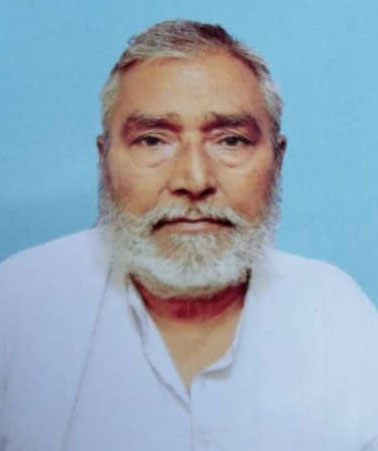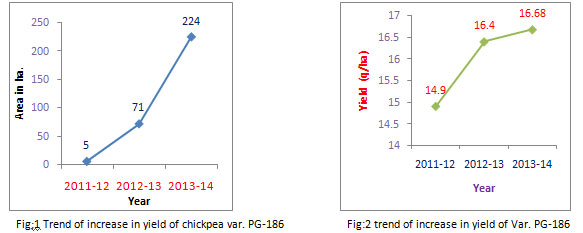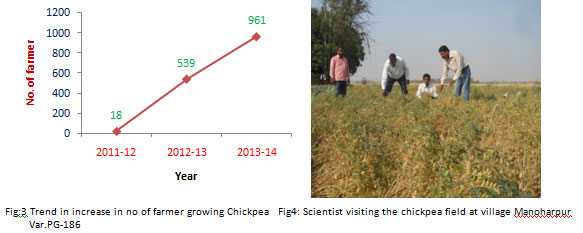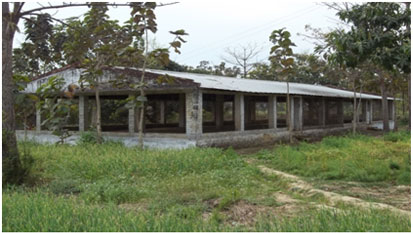Success Story
Income Enhancement of Ram Ujagir Chaudhary by Happy Seeder Machine

Ram Ujagir Chaudhary, a farmer from village- Dhandhra, post- Kamsar, block- Itwa, tehsil- Domariyaganj, district- Siddharthnagar, owns 2.25 hectare land. In addition to farming, he has 3 milk producing buffaloes and 0.2 hectare pond for fish farming. His family comprises 6 members, all dependent on him. Siddharthnagar, a district of Uttar Pradesh comes under the region of Purvanchal in which wheat is important crop during the rabi season.
Earlier, Mr. Chaudhary sowed wheat with the help of Rotavator and cultivator which was costlier to him. Every season, after burning the crop residue he used to be tense and thought of a machine which could turn over the crop residue or cut them into tiny pieces and mix them up in the field. With this thought, one day Mr. Chaudhary reached to the nearest KVK, Sohna, Siddharthnagar and met Dr. L. C. Verma, Senior Scientist and Head and discussed thoroughly about the issue of crop residues. Dr. Verma advised him to chop paddy crop residue with the help of paddy chopper Machine and subsequently use Happy seeder machine to sow the wheat and to eradicate the hectic job of burning the crop residue which in turn will increase the production and fertility of soil.
Scientists advised Mr Chaudhary that he should accept services of KVK to enhance his agricultural income and productivity. After getting satisfied with advices, he decided to use Happy seeder machine on 0.40 hectare and traditional method on 1.10 hectare of land to sow wheat. With the help of Happy seeder, Mr. Chaudhary sowed wheat on 0.40 hectare area during 2019-20 session since 9 November 2019 at almost half the expense of traditional method. Mr. Chaudhary is delighted with sowed wheat and it’s final produce and gives credit to KVK for available techniques analogous to crop residue management project.
Following benefits of Happy seeder machine were realized by Mr. Ram Ujagir Chaudhary-
- With the help of Happy seeder and Mulcher machine, quantity of organic matter increased.
- With this technique of sowing wheat, less irrigation was required.
- In-situ crop residue management technique reduced the amount of chemical fertilizers use in the soil.
- Wheat sown by Happy seeder increased quantity of active tillers in the wheat.
- Wheat crop fall was reduced to minimal by using Happy seeder in comparison to broadcasting methods.
Seeds of Hope
In Siddharthnagar chickpea area is increasing day by day. To meet the increasing demand of pulses, chickpea seed production programme was taken up by KVK Sohna, Siddharthnagar during 2010-11 with the help of Seed production Programme of NDUAT Kumarganj, Faizabad. Chickpea variety PG-186 grown at KVK farm in 2 ha area under late sown condition and produced 29 quintal breeder seed. Farmers visited the chickpea field and got impressed with the performance of crop in late sown condition. They have requested for seed. KVK conducted frontline demonstration on chickpea during 2011-12 in 5 hectare area using Var. Pant G-186 under late sown condition. Farmers achieved average yield of 14.9, 16.4, 16.68 q/ha seed yield during 2011-12, 2012-13 and 2013-14 respectively. Major achievement was that area under chickpea variety PG-186 had increased from 5 hectare to 224 ha within 3 years.
Rice – wheat is the dominant cropping system of Siddharthnagar district occupying about 90 percent area of the total sown area producing ---q/ha rice and 35 q/ha wheat yield but pulse production in the district is very low resulted low availability of protein in the diet of common men. Major reason of low production and productivity is most of the cultivated area affected by flood during rainy season hence there is less scope of kharif pulses and farmers generally like to grow long duration rice variety BPT-5204 or MTU-7029 which delayed the sowing of rabi pulses. Farmers of block Bhanvapur, Etwa, Mithval and Badhni came at KVK and told that their late sown wheat suffers due to terminal heat stress resulted poor wheat yield as well as very low net return. KVK Incharge Dr. D.P. singh and Dr. S.K. Mishra advised them to visit KVK farm and see the late sown chickpea crop. Farmers were very impressed with the performance of chickpea late sown variety Pant G-186 grown at KVK farm. Farmers decided to grow chickpea instead of wheat in next season and they have demanded the seed of variety PG-186. KVK Sohna had conducted a FLD in hectare area with 18 farmers on chickpea during 2011-12 and a training programme on improved production technique of chickpea. KVK gave them seed of PG-186 under FLD with the condition that they will produced seed (T/L ) and provide to the needy farmers in next year.
Farmers harvested an average yield of 14.9 q/ha with a net return of Rs. 29300/ha which was higher than the late sown wheat. Seeing the performance of chickpea variety sown in November last nearby farmers were very impressed and adopted the variety, resulted during 2012-13 area under this variety increased up to 71 hectare and number of farmers increased from 18 to 539. This year average yield of farmers was 16.4 q/ha. Area under this variety in the 4 blocks of Siddharthnagar increasing rapidly and recorded 224 hectare during 2013-14 with an average yield of 16.68q/ha.

Jukhai Prasad Maurya of village Manoharpur block growing chickpea var.PG-186 told that he had left the cultivation gram during 2006-7 due to low yield and heavy infestation of pod borer.KVK gave me seed of this variety during 2011-12 under FLD programme I had harvested 14.89 q/ha seed yield with a net return of Rs. 28470/ha. Which was higher than the wheat and pod borer infestation was controlled by the insecticide recommended by KVK scientist. He also told that now a days field pea, tomato, potato and mustard is suffering from weather vagaries but chickpea yield is increasing year by year with minimum cost of cultivation
Table : Performance of chickpea var. PG-186 at some farmers field.
| Name of Farmer | Yield (q/ha) | Net Returns (Rs/ha) |
|---|---|---|
| Jukhai Prasad Vil. Manoharpu | 2011-12 : 14.89 2012-13 : 15.7 2013-14 : 16.9 |
2011-12 : 28470 2012-13 : 32540 2013-14 : 38660 |
| Ramujagir Dhandhara | 2011-12 : 14.23 2012-13 : 15.5 2013-14 : 16.4 |
2011-12 : 26990 2012-13 : 32300 2013-14 : 36560 |
| Ajijulaha Vill.Dhadana | 2011-12 : 14.92 2012-13 : 16.21 2013-14 : 16.10 |
2011-12 : 29410 2012-13 : 35072 2013-14 : 36240 |
| Badre Alam Badhani | 2011-12 : 13.67 2012-13 : 15.8 2013-14 : 16.6 |
2011-12 : 25810 2012-13 : 33160 2013-14 : 38040 |
| Mohd. Jamil Vill. | 2011-12 : 15.30 2012-13 : 15.70 2013-14 : 16.45 |
2011-12 : 30300 2012-13 : 32740 2013-14 : 37630 |

Fig : 3 Trend in increase in no of farmer growing Chickpea Fig4: Scientist visiting the chickpea field at village Manoharpur. Var.PG-186
Income Generation Through Poultry Farming In District Siddharthnagar
Siddharthnagr is an agriculture based district having geographical area 2.98 lac hectare out of which 2.42 lac hectare in under agriculture. Most of the farmers come under small and marginal category whose income is not sufficient to meet put the daily expenditure of their family. KVK Siddharthnagar established in 1992 and after that started work on find out the source of income generation for the farmers. KVK selected the poultry to reap out the income from poultry. Hence training on poultry farming at KVK started during 1996 with the farmers having backyard poultry to convert it in to commercial poultry.
Poultry Farming in the District
After the inception of KVK, training courses were organized on poultry farming to improve the economic status of the farmers. Since than 53 training courses of 5 to 15 days duration were organized at KVK and 210 school drop outs were trained in poultry farming up to 2014. Out of 210 trainees, 93 have started broiler farming of different capacity ranging from 200 to 8000 birds in their villages. Apart from capacity building a demonstration unit was established at the KVK premises.
Table 1. No. of poultry farm established in the district
| Year | No. Of Training Conducted | No of Participants | No. Of Farm Established by Trainees | No. Of Farm Established by Others | Total no. Of Farm Established |
|---|---|---|---|---|---|
| 1996-2000 | 7 | 48 | 15 | 92 | 107 |
| 2001-2005 | 10 | 82 | 14 | 161 | 185 |
| 2006-2010 | 10 | 100 | 18 | 177 | 205 |
| 2010-2014 | 08 | 80 | 16 | 83 | 109 |
| Total | 35 | 210 | 63 | 513 | 606 |
In this way 30 % trainees started poultry farm after attending training at KVK, which constitute about 10 % of the total established farms of the district (Table 1). It means rest of poultry farm were the impact of technology dissemination by farmers to farmers, radio and print media as well as poultry feed sellers and other agencies. There was an establishment of 606 poultry farms in this period. Maximum no of poultry farm was established in Dumariaganj block followed by Bhanvapur and Naugarh (Table 2).

Table 2. No. Of broiler farms established in the district during 1996 to 2014
| S.N. | Name of Block | 200-500 | 1000-2000 | Above 2000 | Total |
|---|---|---|---|---|---|
| 1 | Khuniyoan | 40 | 50 | 3 | 58 |
| 2 | Itwa | 18 | 13 | 4 | 35 |
| 3 | Dumariaganj | 42 | 22 | 12 | 76 |
| 4 | Jogia | 17 | 6 | 2 | 25 |
| 5 | Kheshraha | 18 | 11 | 1 | 30 |
| 6 | Bansi | 40 | 13 | 4 | 57 |
| 7 | Naugarh | 45 | 12 | 3 | 60 |
| 8 | Barnhi | 38 | 15 | 5 | 58 |
| 9 | Birdpur | 16 | 8 | 5 | 29 |
| 10 | Mithval | 20 | 4 | 2 | 26 |
| 11 | Bhanvapur | 48 | 16 | 2 | 66 |
| 12 | Uska | 19 | 80 | 3 | 30 |
| 13 | Shoratgarh | 24 | 8 | 5 | 37 |
| 14 | Lotan | 11 | 6 | 2 | 19 |
| Total | 396 | 157 | 53 | 606 |
Most of the farm owners started their farm with 200-500 birds. However 26

